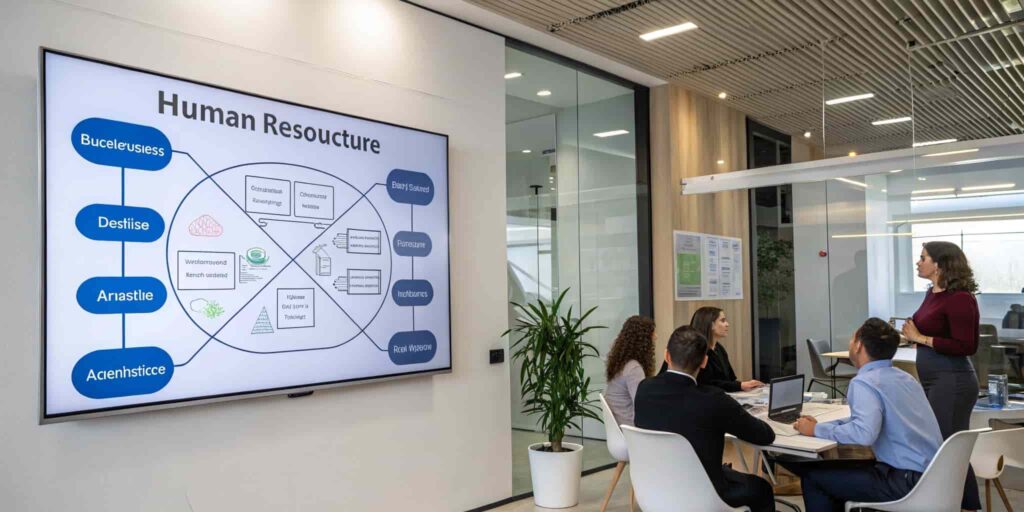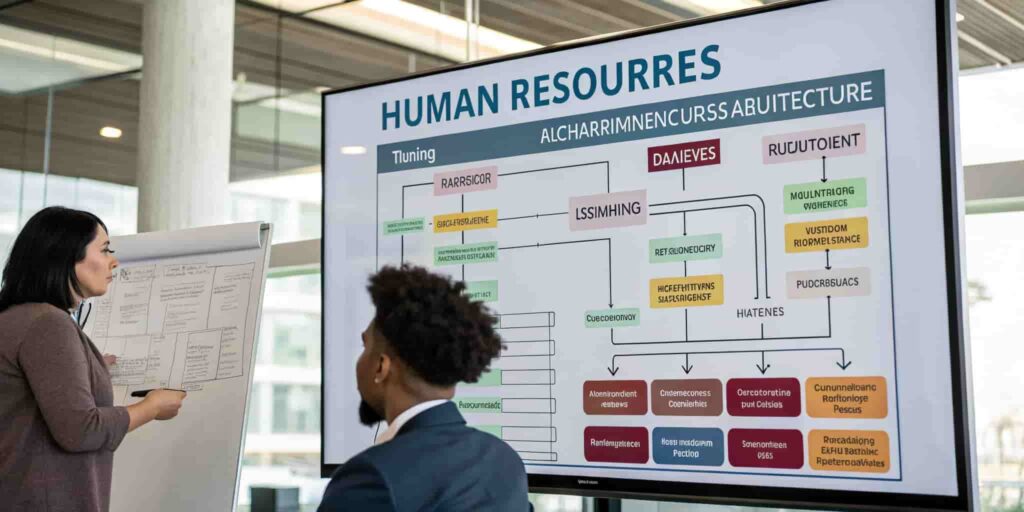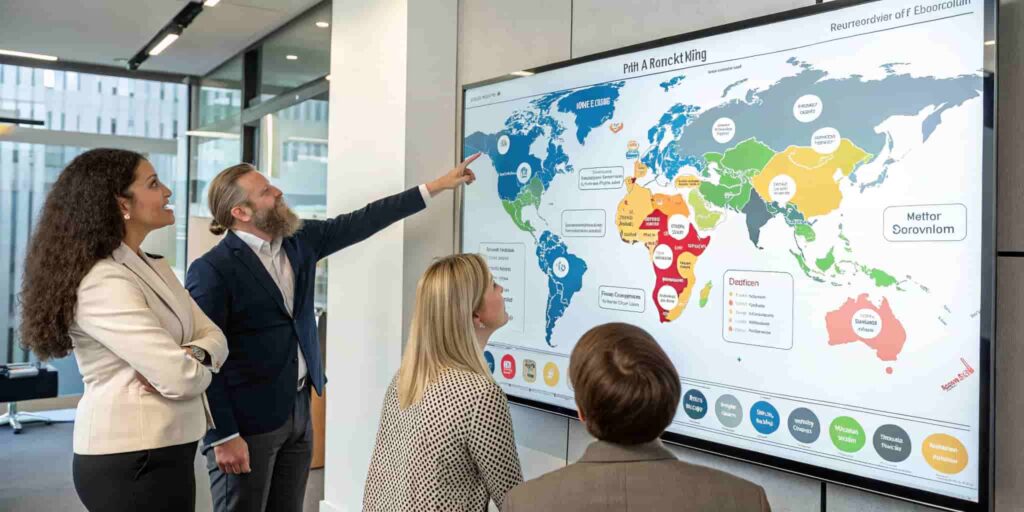In today’s fast-changing business world, Human Resources (HR) plays a much bigger role than just handling administrative tasks. This article explains Business Architecture in HR, a strategic way to align HR functions with the company’s goals. It highlights important tools like capability maps, value streams, and data models to improve efficiency and decision-making.
Real-life examples show how businesses have successfully used these methods to transform HR into a strategic partner. We also discuss common challenges and practical solutions. For HR leaders, this guide offers clear and useful insights to help their teams support business success. With this approach, HR can play a vital role in achieving organizational goals.
What Is Business Architecture In HR?
To start, business architecture HR is a way of aligning human resources with the overall goals of the organization. This approach helps HR move beyond just handling administrative tasks and instead focus on strategic activities that drive business success. Essentially, it acts like a roadmap, guiding HR to better manage talent, improve efficiency, and support business growth.

By using frameworks like business capability maps and data models, HR can identify areas for improvement and make decisions that are informed and data-driven. In short, business architecture empowers HR to play a more active and strategic role in achieving the company’s objectives.
The Evolution Of HR – From Paperwork To Strategic Leadership!
HR has come a long way. It used to be all about payroll, employee records, and compliance. Over time, however, businesses have recognized that a strong HR department is crucial for success. Today, HR is responsible for things like:
- Talent acquisition
- Employee engagement
- Workforce development
- Performance management
- Leadership development
- Succession planning
As the role of HR grew, so did its importance in driving business change and helping the company meet its goals. That’s why tools like business architecture have become essential for ensuring HR is strategically aligned with the rest of the organization.
Related Post: Pedrovazpaulo Business Consultant – Expert Strategies For Growth!
What Are The 4 Elements Of Business Architecture?
So, how does business architecture actually work? Here are the key components that help HR shift from a support function to a strategic powerhouse:
Business Capability Maps:
Business capability maps provide a visual representation of an organization’s HR capabilities. These maps help HR leaders understand their current resources, the skills their team possesses, and the additional capabilities needed to meet the organization’s goals.
Value Streams:
Value streams allow organizations to assess how efficiently HR activities deliver value to the business. By analyzing value streams, HR can identify bottlenecks, inefficiencies, and areas that can be optimized to maximize value delivery.
Business Data Models:
Business data models help HR leaders collect and analyze data to inform decision-making. They provide insights into workforce trends, performance, and other key metrics that drive HR strategies. A data-driven approach allows HR departments to make more informed, effective decisions that align with organizational goals.
Cross-Mapping:
Cross-mapping refers to identifying the impact of changes in HR on other business functions. This technique ensures that HR transformations are integrated across the organization and that changes in HR will not disrupt other business operations.
Related Post: Benitez Roofing Business License Search – How To Verify & Protect Your Home!
How Does Business Architecture Benefit HR?
The real magic of business architecture is that it helps HR become more aligned with the company’s overall strategy. When HR knows how it fits into the bigger picture, it can focus on what really matters and contribute directly to the business’s success. The benefits include:

- Streamlined processes: No more wasted time on redundant tasks—HR can focus on strategic activities.
- Data-driven decisions: With access to the right data, HR can make better, more informed decisions.
- A stronger strategic role: HR can move beyond administrative duties and take a more active part in driving business growth.
How To Implement Business Architecture In HR?
Want to implement business architecture in your HR department? Here’s a simple, step-by-step guide to get you started:
- Start with a Clear Vision: First, define what you want to achieve. Ask yourself: What are the business goals, and how can HR contribute to them? Having a clear vision will guide the entire process.
- Engage Key Stakeholders: Next, involve leaders and teams from different departments to align goals and build support. Collaboration ensures everyone is on the same page.
- Map HR Capabilities: Create a business capability map to identify HR’s current strengths and areas for improvement. This map will act as a guide for future changes.
- Analyze Value Streams: Assess how HR processes deliver value to the business. Identify inefficiencies or bottlenecks that can be optimized for better results.
- Leverage Technology and Data: Use HR analytics, tools, and technology to collect and analyze data. This step ensures decisions are informed and data-driven.
- Prioritize Changes and Take Small Steps: Focus on critical areas first. Implement changes gradually to avoid overwhelming the team or disrupting ongoing operations.
- Measure and Adapt: Regularly track progress using key performance indicators (KPIs). Be ready to adjust your strategies based on feedback and results.
Related Post:Nillkin Acme Sleeve Business Style For Apple Macbook 13 Inch – Stylish & Secure!
Business Architecture HR Job Description – Dont Miss Out!
Once you’ve got a solid understanding of how to implement business architecture in HR, you might be wondering what kind of role a Business Architecture HR professional plays in this process. Here’s a job description for that role:
A Business Architecture HR professional is responsible for aligning HR strategies with the organization’s overall business objectives. This role ensures that HR moves beyond administrative functions to become a strategic partner that directly contributes to the success of the organization.
Key Responsibilities:
- Strategic Alignment: Work closely with business leaders to align HR goals with company objectives.
- Capability Mapping: Develop and maintain maps to assess HR’s strengths and areas for improvement.
- Optimizing HR Processes: Identify and streamline inefficient processes to improve the overall effectiveness of HR.
- Data-Driven Decisions: Use HR data and analytics to make informed decisions about talent acquisition, development, and workforce planning.
- Collaboration: Work across departments to integrate HR strategies into the broader business functions.
- Leading Change: Manage HR transformation projects and drive change within the organization.
- Continuous Improvement: Regularly assess and refine HR processes to adapt to evolving business needs.
Required Skills:
- HR Expertise: A deep understanding of HR functions and best practices.
- Strategic Thinking: Ability to think long-term and align HR with business goals.
- Analytical Skills: Proficiency in data analysis and HR metrics.
- Project Management: Experience in leading large-scale HR projects.
- Communication Skills: Strong ability to communicate complex ideas effectively.
Qualifications:
- A degree in Human Resources, Business Administration, or a related field.
- Relevant certifications, such as in Business Architecture or TOGAF, are a plus.
- Previous experience in HR leadership, especially with exposure to business architecture methodologies.
Tools And Technologies For Business Architecture In HR – Need To Know!
To make business architecture work in HR, you need the right tools. Here are some that can help:
| Tool/Technology | Purpose |
| HR Analytics Platforms | Collect and analyze workforce data for informed decision-making. |
| Value Stream Mapping Tools | Assess and optimize the efficiency of HR processes. |
| Employee Engagement Software | Enhance communication and measure employee satisfaction. |
| HRIS (Human Resource Information Systems) | Manage employee records, payroll, and compliance efficiently. |
| AI-Driven Recruitment Tools | Automate talent acquisition and improve hiring decisions. |
| Collaboration Platforms | Foster communication among stakeholders during implementation. |
| Business Process Management (BPM) Tools | Streamline and automate HR workflows for greater efficiency. |
| Data Visualization Software | Create dashboards and reports for tracking HR transformation progress. |
How Business Architecture In HR Drives Organizational Success?
It’s not just about improving HR—it’s about improving the entire organization. When HR’s goals are aligned with the broader business strategy, the whole company benefits. HR can help drive:
- Innovation: HR can build the talent pipeline needed for future growth.
- Productivity: By focusing on employee engagement and development, HR drives performance.
- Customer Satisfaction: A motivated, skilled workforce leads to better service.
- Company Culture: HR shapes a positive culture that supports long-term success.
When HR is aligned with business goals, it becomes a key partner in driving these outcomes, helping the organization stay competitive and thriving in the marketplace.
Related Post:British Airways Business Class – A Great Upgrade!
What Is The Role Of Business Capability Maps In HR?
To begin with, business capability maps serve as a visual tool that helps HR leaders understand their current strengths and weaknesses. By mapping out the key HR capabilities, these maps provide a clear picture of what HR can already do well and what areas need improvement.

They help HR teams identify skill gaps, allowing them to focus on the development of specific areas to better support the organization’s needs. Furthermore, business capability maps allow HR to prioritize tasks and make more informed decisions about where to allocate resources for maximum impact. In the long run, these maps guide HR in aligning its functions with the broader goals of the organization, ensuring a more strategic approach to workforce management.
Real-World Examples Of Business Architecture In HR – You Must Read!
Several organizations have successfully implemented business architecture to transform their HR functions. Let’s look at a couple of examples:
Tech Titan Inc.:
Tech Titan Inc., a global technology company, struggled with talent retention and employee engagement. By implementing business architecture in HR, they were able to identify gaps in their HR capabilities and develop a more effective talent development program. The result was improved organizational agility, better employee engagement, and a more substantial talent pipeline.
Healthcare Hero Ltd.:
Healthcare Hero Ltd., a leading healthcare provider, faced operational inefficiencies within its HR function. By leveraging business architecture, the company was able to streamline its HR processes and improve service delivery. This transformation resulted in better talent management practices, improved employee satisfaction, and more effective workforce management.
Retail Revolution Co.:
Another example is Retail Revolution Co., a fast-growing retail business. By using business architecture, HR was able to map out the specific skills needed in the retail industry and align them with business goals. This strategic alignment allowed HR to develop a targeted recruitment and training program, ensuring they hired employees with the right skills and improved overall performance across the company.
Related Post: Business E320 5G Router – Boost Your Enterprise Connectivity!
What Challenges Come With Implementing Business Architecture In HR?
Of course, like any change initiative, there are challenges. Here are some common ones:
- Resistance to Change: Employees and leaders may be hesitant to adopt new processes or frameworks, especially if they are comfortable with existing practices. Overcoming this resistance requires clear communication and strong leadership to highlight the benefits.
- Alignment of Stakeholders: Different departments or business units may have varying priorities, making it difficult to align HR strategies with broader organizational goals. It’s important to ensure that all stakeholders understand the value of business architecture.
- Lack of Expertise or Resources: Business architecture requires specific skills and tools, which may not be readily available in-house. Organizations may need to invest in training or external expertise to successfully implement it.
- Integration with Existing Systems: Many HR functions are already supported by legacy systems, and integrating business architecture into these systems can be complex and time-consuming. Ensuring compatibility with existing technologies is crucial.
- Measuring ROI: Business architecture in HR may take time to show measurable results, and the long-term impact on the organization can be difficult to quantify. It’s essential to set clear metrics from the beginning to track progress.
Related Post:Grow Google Business Profile Audience – Proven Tips For Instant Growth!
The Future Of Business Architecture In HR – What’s Next!
As businesses continue to face increasing competition and complexity, HR’s role will only become more strategic. Business architecture will remain key in helping HR departments align their efforts with organizational goals and drive success.

The future of business architecture in HR will likely include:
- Further integration of HR systems with other business functions
- Increased use of AI and machine learning to drive decision-making
- A focus on continuous improvement and adaptability in HR processes
- Greater emphasis on employee experience and well-being
HR will continue to evolve, and business architecture will be a critical framework for its transformation.
FAQs:
What are viewpoints in business architecture for HR?
Viewpoints in business architecture for HR are different perspectives used to analyze and prioritize HR initiatives. They help HR leaders focus on strategic goals, assess the impact of changes, and make informed decisions based on various business needs.
What are business architecture methodologies?
Business architecture methodologies are structured approaches to designing business functions aligned with strategic goals. They include tools like capability mapping, value stream analysis, and process optimization.
Can business architecture help improve organizational agility?
Yes, by aligning HR processes with business needs and identifying areas for improvement, business architecture helps HR departments become more agile and responsive to changes in the business environment.
How does business architecture help in talent management?
Using data models and value streams, business architecture helps HR identify the best talent acquisition and development strategies, improving talent retention and employee engagement.
What is Business Architecture certification?
Business Architecture certification validates expertise in creating and implementing business architecture frameworks. It helps professionals gain in-depth knowledge and skills for aligning business functions with strategic goals.
Where can I find a Business Architecture PDF?
Business Architecture PDFs can be found on resources like the Business Architecture Guild or academic websites. These PDFs contain guidelines, frameworks, and methodologies for effective business architecture design.
What is TOGAF Business Architecture?
TOGAF Business Architecture is a framework that helps organizations design, plan, and manage business processes. It aligns business operations with strategic goals, improving efficiency and effectiveness across departments.
Conclusion:
Business Architecture in HR empowers organizations to transform their HR functions from administrative backbones to strategic partners. By aligning HR with overall business objectives, leveraging data-driven insights, and streamlining processes, companies can unlock significant value.
Implementing this framework requires a clear vision, stakeholder engagement, and a commitment to continuous improvement. By embracing Business Architecture, HR can play a pivotal role in driving innovation, enhancing employee experience, and ultimately achieving sustainable organizational success.
Take Analysis To: